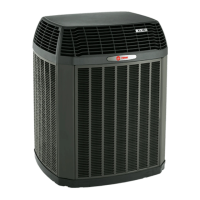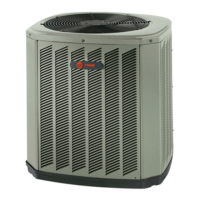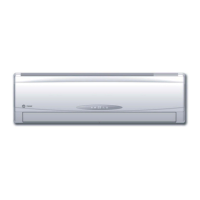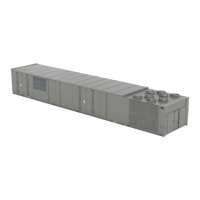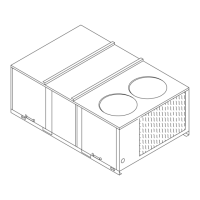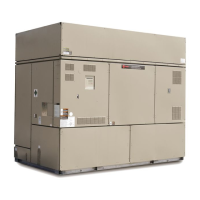Installer's Guide
c. If the unit is suspended, it must be supported
from the bottom near both ends as well as the
middle to prevent sagging. The service access
must remain unobstructed. If the unit is sup-
ported along the length of the front and back, the
air handler only needs to be suspended at both
ends. See Figure 8.
d. If the unit is not suspended it must be supported
as mentioned above and isolated carefully to pre-
vent sound transmission. Vibration isolators (pur-
chased locally) must be placed under the unit.
e. It is always recommended that an auxiliary drain
pan be installed under a horizontal Air Handler
(See Condensate Drain Piping) to prevent pos-
sible damage to ceilings.
f. Isolate the auxiliary drain pan from the unit or
from the structure.
g. Connect the auxiliary drain line to a separate
drain line (no trap is needed in this line) and ter-
minate according to local codes.
h. If a return duct is connected to the air handler, it
must be the same dimensions as the return
opening shown in the outline drawings on page
18.
i. Openings where field wiring enters the
cabinet must be completely sealed. Location
of power entry is shown on the outline drawing.
Use 2.5" clear stickers to seal all unused electri-
cal knockouts. See Figure 9.
j. After ductwork connections are made, seal air-
tight and per local codes.
Figure 12 FlangeAttachment
D. DUCT CONNECTIONS
The supply and return air ducts should be connected to
the unit with flame retardant duct connectors. Convert-
ible duct flanges are provided on the discharge opening
to provide a "flush fit" for 3/4" or 1-1/2" duct board appli-
cations, see the Outline drawing on page 18 for sizes of
the duct connections. After the duct is secured, seal
around the supply duct to prevent air leakage.
NOTE: If the convertible duct flanges are not used, they
must be removed and discarded for proper airflow.
Control box must be removed to install or service
heater accessory or communicating controls. See Fig-
ure 13.
fo- -_.
\
/
/
/
i,
Figure 13 _ ....
/
/
/
NOTE: Do NOT cover up control box screws with duct
work.
NOTE: Any duct board return connection can be made
to the sides of the unit using tape or mastic.
E. REFRIGERANT PIPING
IMPORTANT:
Refrigerant piping must be routed to maintain service
access to blower compartment and provide easy re-
moval of filter access panel and filter.
1. Refrigerant connections are made outside the cabi-
net.
NOTE: TXV bulb MUST be protected (wrap a wet rag
around the suction line between the TXV bulb and the
braze joint) or removed, while brazing the tubing. Over-
heating of the sensing bulb will affect the functional
characteristics and performance of the air handler.
NOTE: Penetration around the Refrigerant lines must
be sealed and Electrical inlets should be sealed at
both the low and the high voltage.
2. Installation of refrigerant lines is covered in the in-
stallation instructions packaged with the outdoor
unit. Evacuation, leak testing and brazing proce-
dures are included in those instructions. Read those
instructions before starting installation of refriger-
ant lines.
8 18-GEl 1D1-4

